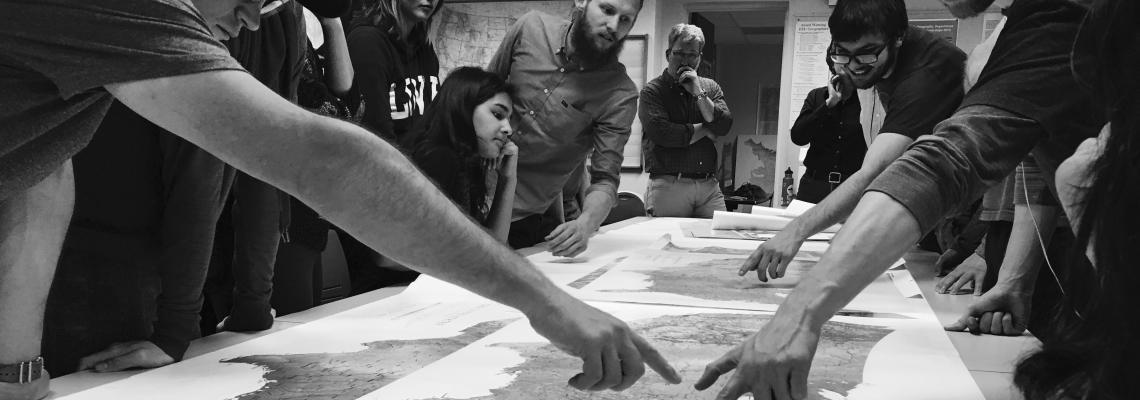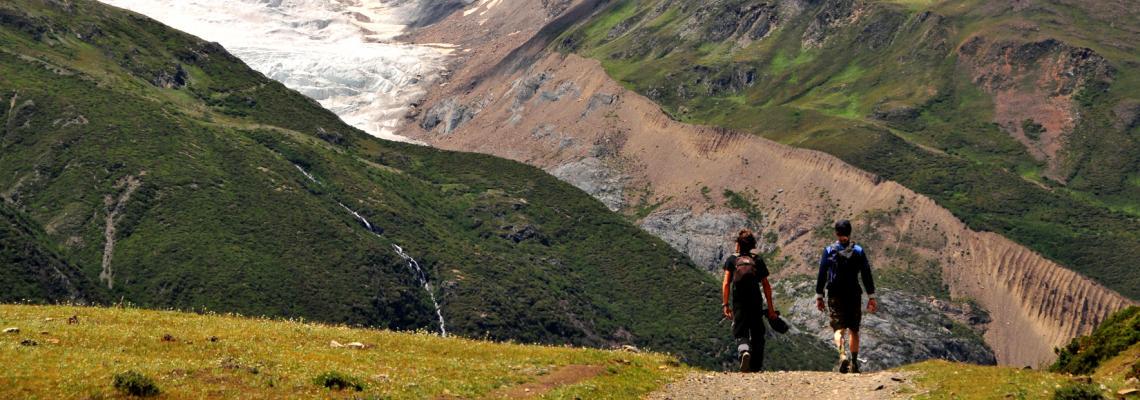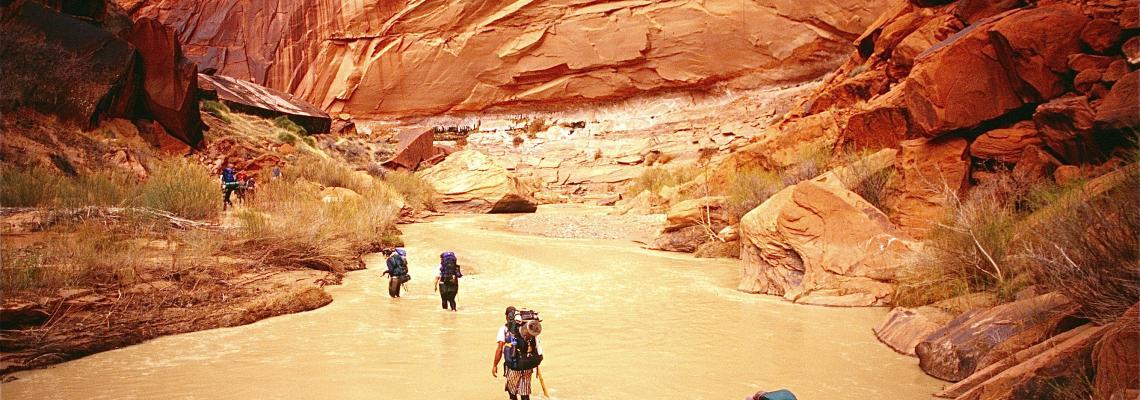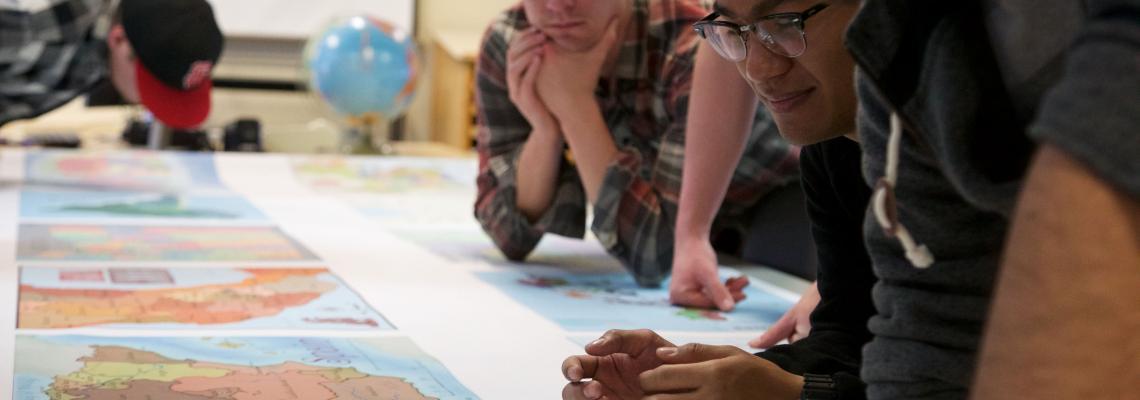...
Our Programs
Geography, B.A.
Find your future at Cal Poly Humboldt. Working in small classes, inside and outside, and in our state-of-the-art geospatial lab, you explore humankind's ever-changing relationship to the environment. Then you use what you know, undertaking important research topics that interest you—like global warming, deforestation, ethnic conflict, urban planning and much more—in places that inspire you.
Geospatial Science & Technology, B.S.
The Humboldt Geospatial Science & Technology major allows students to pursue a wide range of interests within the natural and social sciences. Field experience, community involvement, knowledge of particular world regions, and development of a global awareness are emphasized.
Geography Professor Dr. Gabi Kirk Publication
Kirk, G., (2024) “"A fairly good crop for white men:" The political ecology of agricultural science and settler colonialism between the US and Palestine”, ... Read More
Geography Professor Dr. Amy Rock Co-Investigates $1 Million NSF Initiative to Support Foreign-Born Women Faculty in Geospatial Sciences
For more information: https://now.humboldt.edu/... Read More
Dr. Rosemary Sherriff Featured on Yeah, I Got an F#%*ing Job With a Liberal Arts Degree Podcast
Yeah, I Got an F#%*ing Job With a Liberal Arts Degree is a show that takes a deep look at the humanities and higher education more generally. Join Cal Poly Humboldt Dean... Read More
2024 Scholarship & Award Recipients
Congratulations to GESA's 2024 Scholarship & Award Receptients!
NCGE Award - Owen Nawrath
Kosmos Award - Lynn Spencer
Webb Bauer Award - Chris Tuck
... Read MoreGeography, Environment & Spatial Analysis to host APCG's Annual Conference Fall 2024
Cal Poly Humboldt's Dept. of Geography, Environment & Spatial Analysis will be hosting the Association of Pacific Coast Geograpers (APCG) annual conference on campus... Read More
As part of a geography course led by Rosemary Sherriff, eleven students attended the annual California Geographic...
MEET FACULTY, MEET ALUMNI
Get to know your professors, who they are as geographers, who they are as people. And...
National Geographic Society Emerging Explorer M Jackson is the author of While Glaciers Slept: Being Human in a Time of Climate Change (2015) and...
It is the Cartography Club's pleasure to be hosting our annual GIS Day conference on Wednesday, November 15th!
11am - 2pm: Mapathon in FH106...
About Neil Allen of Benchmark Maps - As a cartographer, Neil is constantly enjoying the landscape whether it be in person or...
It is the Geospatial Club's pleasure to be hosting our annual GIS Day conference on Wednesday, November 16th! GIS Day is an international...
Join us for a discussion about the beauty of maps.
...
As a Chief Cartographer at Metro, Matthew provides analysis, creates maps, visualizations and infographics of transportation networks to...
Micah Wright and Rosemary Sherriff published a new article on climate change impacts in forests in Southwest Alaska with National Park Service collaborators in the open-access journal Ecosphere. Results suggest that historically productive forests in Southwest Alaska are showing declines in growth under warmer conditions, with important implications for future forest conditions and productivity. Our results corroborate climate change model forecasts for the region. Article weblink: https://doi.org/10.1002/ecs2.2462
PermaLinks: http://now.humboldt.edu/achievements/10650/
On a weekend in late September 2018, more than twenty Cal Poly Humboldt Geography students, led by professors Matthew Derrick and Rosemary Sherriff, hopped in vans for a three-day field study that included an investigation into the impacts of the recent Carr Fire and an exploration natural beauty of Lassen Volcanic National Park.
The Carr Fire, reported as one of the most destructive fires in California’s history, started on July 23, 2018, near Whiskeytown off Highway 299. Before being fully contained in late August, the conflagration spread nearly 230,000 acres across Trinity and Shasta counties, destroying more than 1,000 residences—mainly in and around west Redding—and claiming the lives of three firefighters.
On the first day of the field study, the Humboldt geographers met with Tom Garcia, a firefighter at National Park Service, and Eric Knapp, a research ecologist with the US Forest Service. Starting at the Whiskeytown National Recreation Area, students listened to Garcia as he discussed the origins of the fire and the damage it inflicted in and around the park. Garcia also explained, through a guided—and nearly off-road—tour of park land impacted by the Carr Fire, the National Park Service’s efforts to ameliorate the worst effects of forest fires through controlled burns.
After surveying some of the fire’s impacts to the park land, the Humboldt geographers continued with Knapp to examine some of the devastation inflicted on human settlements, including the destruction of homes and human life by what has been reported as the state’s worst-ever fire tornado. According to Knapp, the fire vortex, which claimed the life of Redding-based firefighter Jeremy Stoke, was so unusual that fire ecologists and other experts are still grappling to understand it.
Students and faculty alike were struck, sometimes on a very emotional level, by the landscapes of destruction they viewed in relatively wealthy neighborhoods located in west Redding at the wildland-urban interface. Fire razed some homes to their foundations while neighboring homes stood seemingly unscathed, leaving an impression of randomness in scorched path. However, as Knapp explained, while a degree of randomness characterized the fire, choices in home building materials, efforts to stave off air flow in and out of houses, relative location vis-à-vis the wildland, and other pertinent variables help explain resultant geographic patterns of destruction and clemency.
Following their examination of the Carr Fire, the Humboldt geographers traveled out to Lassen Volcanic National Park, where they set up camp for two days. Faculty led a series of explorations, including a hike to the top of Lassen Peak, surveying the natural beauty and wonder found in the park’s landscapes.
PermaLink: http://now.humboldt.edu/dept_happenings/10656/
Geography professors Matthew Derrick and Rosemary Sherriff co-edited the 2018 issue of The California Geographer, the flagship peer-reviewed journal of the California Geographical Society. The volume—weighing in at more than 270 pages, the largest in journal’s nearly six-decade history—features articles from Humboldt Geography faculty, including Derrick and Nicholas Perdue, and former students, including Nathaniel Douglass and Eric Fowler, as well as academic geographers from throughout the state. The 2018 issue marks the second year of Derrick and Sherriff editing the journal; it can be accessed at the following link: http://scholarworks.csun.edu/handle/10211.3/203086
Rosemary Sherriff and Lucy Kerhoulas received an NSF Award for ~$400,000 for three years to assess differential response of conifers to drought across geographic gradients. The project uses the recent, severe California drought as a test case to yield important insights on the effects of multi-year drought stress, competition and habitat factors. This information is needed to model tree responses to climate change and as input for forest management in the face of future wildfire. The project involves field sampling and analysis of tree-ring growth and carbon isotope ratios. The team will involve undergraduate and graduate students and multiple collaborators.
PermaLink: http://now.humboldt.edu/achievements/11051/






